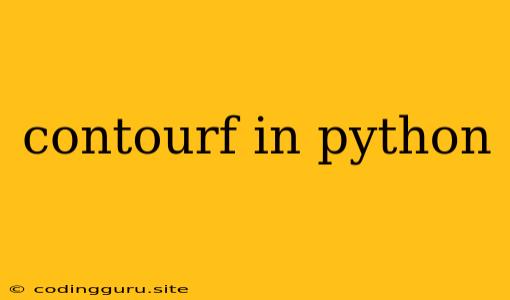Contourf in Python: A Comprehensive Guide to Visualizing 2D Data
In the realm of data visualization, Python has emerged as a powerful tool, offering a wide array of libraries for crafting informative and visually appealing graphics. Among these libraries, Matplotlib stands out as a versatile and widely used option, providing a rich set of tools for creating static, animated, and interactive visualizations.
One particular function within Matplotlib, contourf, plays a crucial role in representing two-dimensional data by creating filled contours. This function enables us to visualize the distribution of data across a plane, highlighting regions with similar values and revealing patterns and trends within the dataset.
Understanding the Basics of Contourf
What is contourf?
At its core, contourf is a Matplotlib function designed to create filled contours, essentially depicting regions of equal values within a two-dimensional dataset. Imagine a topographic map, where lines connect points of equal elevation; contourf works similarly by filling areas with the same value, providing a visual representation of the data's distribution.
How does contourf work?
The contourf function takes a set of x and y coordinates, along with corresponding data values, as input. It then generates a series of contours, defined by the specified levels of data values. These contours are then filled with colors or shades, creating a visually appealing map of the data's distribution.
Essential Arguments for contourf
contourf offers a range of arguments that allow you to customize the appearance and behavior of the generated contours. Here are some of the most important arguments:
x, y, z: These arguments define the coordinates and data values for the contours.levels: This argument specifies the values that define the contours. It can be a list or an array of values, or you can use a convenient shortcut like'auto'to automatically determine the levels.cmap: This argument controls the colormap used for filling the contours. You can choose from a wide variety of built-in colormaps or define your own custom colormap.alpha: This argument sets the transparency of the filled contours, allowing you to adjust the visual weight of the contours.
Applying contourf to Real-World Data
Let's illustrate the power of contourf through a real-world example. Suppose we have a dataset representing temperature measurements across a geographical area. We can use contourf to create a visually informative map showcasing the temperature distribution:
import matplotlib.pyplot as plt
import numpy as np
# Sample data for temperature distribution
x = np.arange(0, 10, 0.1)
y = np.arange(0, 10, 0.1)
X, Y = np.meshgrid(x, y)
Z = np.sin(X) * np.cos(Y)
# Create the contourf plot
fig, ax = plt.subplots()
contour = ax.contourf(X, Y, Z, levels=20, cmap='viridis')
# Add a colorbar to visualize the temperature range
cbar = fig.colorbar(contour, label='Temperature (°C)')
# Set labels for the x and y axes
ax.set_xlabel('Longitude')
ax.set_ylabel('Latitude')
# Set the title of the plot
ax.set_title('Temperature Distribution')
plt.show()
This code generates a filled contour plot with 20 levels, using the 'viridis' colormap to represent the temperature distribution. The colorbar provides a visual key to interpret the color variations in the map.
Tips for Effective Contourf Visualization
- Choose the right colormap: Consider the nature of your data and the message you want to convey. A diverging colormap like 'coolwarm' is suitable for highlighting both high and low values, while a sequential colormap like 'viridis' is suitable for representing increasing or decreasing trends.
- Adjust the level values: Experiment with different levels to control the granularity of the contours. More levels provide finer detail but can lead to a cluttered plot.
- Add contour lines: You can combine
contourfwithcontourto overlay contour lines on the filled contours, providing additional visual cues for the data distribution. - Enhance readability with labels and annotations: Consider adding labels to the axes, a title to the plot, and annotations to highlight specific regions of interest.
Beyond the Basics: Advanced Contourf Techniques
Matplotlib's contourf function offers a variety of advanced features to create more sophisticated visualizations. Here are a few examples:
- Customizing contour lines: You can control the thickness, color, and style of the contour lines using arguments like
linewidths,colors, andlinestyles. - Hatching: You can add hatching patterns to the filled contours using the
hatchesargument. - Interpolation: The
interpargument enables you to control the interpolation method used for creating the contours.
Conclusion
contourf in Python, powered by Matplotlib, offers a powerful and versatile tool for visualizing two-dimensional data, providing a clear and informative representation of its distribution. By understanding the basic arguments, exploring the available options, and employing advanced techniques, you can create compelling contour plots that reveal valuable insights from your data. Whether you are analyzing weather patterns, studying geological formations, or exploring complex scientific data, contourf provides an indispensable means to visualize your findings effectively.
